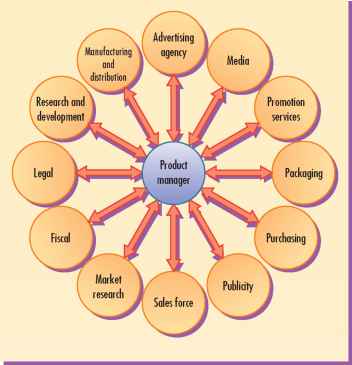Product or Brand Management Organization
Companies producing a variety of products and brands often establish a product (or brand-) management organization. The product-management organization does not replace the functional management organization but rather serves as another layer of management. A product manager supervises product category managers, who in turn supervise specific product and brand managers. A product-management organization makes sense if the company's products are quite different, or if the sheer number of products is beyond the ability of a functional marketing organization to handle. Kraft uses a product-management organization in its Post Division. Separate product category managers are in charge of cereals, pet food, and beverages. Within the cereal product group, there are separate subcategory managers for nutritional cereals, children's presweetened cereals, family cereals, and miscellaneous cereals.
Product and brand managers have these tasks:
■ Developing a long-range and competitive strategy for the product
■ Preparing an annual marketing plan and sales forecast
■ Working with advertising and merchandising agencies to develop copy, programs, and campaigns
■ Stimulating support of the product among the sales force and distributors
■ Gathering continuous intelligence on the product's performance, customer and dealer attitudes, and new problems and opportunities
■ Initiating product improvements to meet changing market needs
FIGUR E 6-6 Functional Organization part five
Managing and Delivering Marketing Programs
|
II | ||||
|
« « « « « | ||||
|
Marketing administration manager |
Advertising and sales-promotion manager |
Marketing research manager |
New-products manager | |
These tasks are common to both consumer- and industrial-product managers. However, consumer-product managers typically manage fewer products and spend more time on advertising and sales promotion. They are often younger and MBA-educated. Industrial-product managers spend more time with customers and laboratory and engineering personnel, think more about the technical aspects of their product and possible design improvements, and work more closely with the sales force and key buyers.
The product-management organization introduces several advantages. The product manager can concentrate on developing a cost-effective marketing mix for the product. The product manager can react more quickly to problems in the marketplace than a committee of functional specialists can. The company's smaller brands are less neglected, because they have a product advocate. Product management also is an excellent training ground for young executives, because it involves them in almost every area of company operations (Figure 6-7).
But a product-management organization has some disadvantages. First, product management creates some conflict and frustration. Typically, product managers are not given enough authority to carry out their responsibilities effectively. They have to rely on persuasion to get the cooperation of advertising, sales, manufacturing, and other departments. They are told they are "minipresidents" but are often treated as low-level coordinators. They are burdened with a great amount of paperwork. They often have to go over the heads of others to get something done.
Second, product managers become experts in their product but rarely achieve functional expertise. They vacillate between posing as experts and being cowed by real experts. This is unfortunate when the product depends on a specific type of expertise, such as advertising.
Third, the product management system often turns out to be costly. One person is appointed to manage each major product. Soon product managers are appointed to manage even minor products. Each product manager, usually overworked, pleads for an associate brand manager. Later, both overworked, they persuade management to give them an assistant brand manager. With all these people, payroll costs climb. In the meantime, the company continues to increase its functional specialists in copy,

The Product Manager's Interactions chapter 22
Managing the Total Marketing Effort
(a) Vertical product team
|
PM | |||||
|
R |
C |
S |
D |
F |
E |
c) Horizontal product team
M = product manager APM = associate product manager 'A = product assistant = market researcher = communication specialist = sales manager = distribution specialist = finance/accounting specialist = engineer
FIGURE
Three Types of Product Teams part five
Managing and Delivering Marketing Programs packaging, media, sales promotion, market surveys, and statistical analysis. The company is soon saddled with a large and costly structure.
Fourth, brand managers normally manage a brand for only a short time. Either they move up in a few years to another brand, or they transfer to another company. Short-term involvement with the brand leads to short-term marketing planning and plays havoc with building the brand's long-term strengths.
Fifth, the fragmentation of markets makes it harder to develop a national strategy from headquarters. Brand managers must please more regional-based trade groups and rely more on the local sales force.
Pearson and Wilson have suggested five steps to make the product management system work better:6
1. Clearly delineate the limits of the product manager's role and responsibility.
2. Build a strategy-development-and-review process to provide a framework for the product manager's operations.
3. Take into account areas of potential conflict between product managers and functional specialists when defining their respective roles.
4. Set up a formal process that forces to the top all conflict-of-interest situations between product management and functional line management.
5. Establish a system for measuring results consistent with the product manager's responsibilities.
A second alternative is to switch from product managers to product teams. There are three types of product-team structures in product management (Figure 6-8):
1. Vertical product team: Product manager, associate product manager, and product assistant (Figure 6-8[a]). The product manager is the leader and deals with other managers to gain their cooperation. The associate product manager assists in these tasks and also does some paperwork. The product assistant carries out most of the paperwork and routine analysis.
2. Triangular product team: Product manager and two specialized product assistants, one who takes care of marketing research and the other, marketing communications (Figure 6-8[b]). The Hallmark Company uses a "marketing team" consisting of a market manager (the leader), a marketing manager, and a distribution manager.
3. Horizontal product team: Product manager and several specialists from marketing and other functions (Figure 6-8[c]). 3M has teams consisting of a team leader and representatives from sales, marketing, laboratory, engineering, accounting, and marketing research. Dow Corning sets up teams of five to eight people; each team manages a specific product, market, and process.
A third alternative is to eliminate product manager positions for minor products and assign two or more products to each remaining manager. This is feasible where two or more products appeal to a similar set of needs. A cosmetics company does not need separate product managers for each product because cosmetics serve one major need—beauty. A toiletries company needs different managers for headache remedies, toothpaste, soap, and shampoo, because these products differ in use and appeal.
A fourth alternative is to introduce category management, in which a company focuses on product categories to manage its brands. Here are two examples:
■ G aM For General Motors, products are categorized by the make of car, and each division offers a range of models to appeal to a specific market segment. Cadillacs, of course, are the eponymous status symbol of the industry. Buicks are intended to appeal to professionals such as doctors and lawyers; Pontiacs and Oldsmobiles, to the driver who wants a sporty image; and Chevrolets, to the average driver looking for a practical means of transportation. These distinctions can be traced back to Alfred Sloan's idea of "a car for every pocketbook." But over the years, the divisions lost sight of their individual target customer as each attempted to develop a full line of mod els for the entire car-buying market. When Ronald Zarrella was hired as vice president for marketing of GM's North American group in 1994, his mission was to reestablish the five brand images of the five divisions. Under his leadership, each brand is headed by a brand manager and a vehicle line executive. The brand manager's responsibility is to know the brand's market and to ensure that the entire marketing effort—product engineering and design, advertising, merchandising, and pricing—is directed toward that target. The vehicle line executive oversees the development of a line of automobiles that meets the target customer's needs. Models that don't support a division's image, such as the Buick Skylark and Roadmaster and Chevrolet Caprice, are discontinued.7
■ K a Kraft has changed from a classic brand-management structure, in which each brand competed for organizational resources and market share, to a category-based structure in which category business directors (or "product integrators") lead cross-functional teams composed of representatives from marketing, R&D, consumer promotion, and finance. The category business directors have both broad responsibility and bottom-line accountability. No longer viewed solely as marketers, they are as responsible for identifying opportunities to improve the efficiency of the supply chain as they are for developing the next advertisement. Kraft's category teams work in conjunction with process teams dedicated to each product category and with customer teams dedicated to each major customer (Figure 6-9).8
Category management is not a panacea. It is still a product-driven system. Colgate recently moved from brand management (Colgate toothpaste) to category management (toothpaste category) to a new stage called "customer-need management" (mouth care). This last step finally focuses the organization on a basic customer need.9
Was this article helpful?
Readers' Questions
-
adonay17 days ago
- Reply
-
keijo17 days ago
- Reply
-
hassan1 year ago
- Reply

